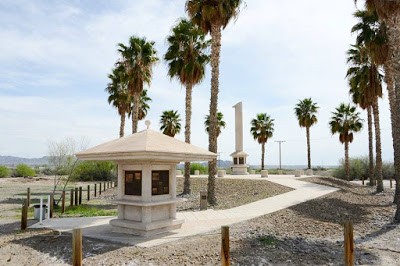Colorado River Relocation Center
Introduction
Text-to-speech Audio
Images
Poston Memorial Monument

Backstory and Context
Text-to-speech Audio
The Colorado River Relocation Center was referred to as Poston, after Charles D. Poston, who was the first Superintendent for Indian Affairs in Arizona. Poston was extremely hot, with temperatures well over 100 degrees in the summer. In the winter, nighttime temperatures sometimes dropped to freezing and below. The heat and constant wind which blew sand into the barracks prompted those incarcerated at Poston to refer to it as Roasten, Toastin, and Dustin.
The Colorado River is located approximately three miles from Poston, which was established on the Colorado River Indian Reservation, against the wishes of the Tribal Council. The Tribal Council was overruled by the Office of Indian Affairs and the army. Today, the Colorado River Indian Tribes is comprised of four tribes, the Mohave, Chemehuevi, Hopi, and Navajo.
Poston included three separate camps and had a peak population of 17,814, the majority U.S. citizens from Southern California. It was Arizona's third largest city at the time and the second largest confinement center of the war. A single fence surrounded the entire camp, with a separate area outside the fence for army guards' barracks. The barracks that served as living quarters had no cooling systems, the dark tar paper walls only absorbing more heat. As people arrived in the desert in May 1942, the temperatures were well above 100 degrees. There were fatalities due to heat stroke and lack of health facilities.
After traveling for a day or more by bus to Poston, each adult was required to answer questions about their occupation, proceed to fingerprinting, then off to another barrack to stand in line for a housing assignment, and after that a physical examination. Only after all this, were families loaded into trucks and driven to their barrack.The space allotted to each family in a barrack was a 20 by 25-foot barren room, with four family "apartments" in each barrack divided by hanging cloth partitions. For each person, there was one Army cot, one blanket, and one piece of cloth for a mattress, which they had to fill with hay.
The Poston Elementary School complex included 13 adobe school buildings constructed in 1943 and designed by Yoshisaku Hirose, a Japanese-born architect. The school contained a wood shop, an auditorium, a craft and supply building, a school office, a library, eight classroom buildings, and a network of concrete sidewalks with canopies.The majority of the 1,900 camp structures were removed after Poston closed in November 1945 and the land was returned to the Colorado River Indian Tribes. Today, most of the land around the relocation center is irrigated farm fields. The Poston Memorial Monument was built in 1992, on tribal land with tribal support.
Restoration of specific camp features by the Poston Restoration Project is ongoing, with a stated mission to restore the Camp 1 school auditorium, classrooms and barracks as living museums to exhibit the personal stories and archival items for visitors and researchers. A pilgrimage of families incarcerated at Poston was held in April 2018, with an official welcome by the Colorado River Indian Tribes.
Sources
Poston (Colorado River). Densho Encyclopedia. . Accessed April 10, 2018. http://encyclopedia.densho.org/Poston_(Colorado_River)/.
Poston Elementary School, Unit I Poston, Arizona. National Park Service. . Accessed April 10, 2018. https://www.nps.gov/nr/travel/asian_american_and_pacific_islander_heritage/poston-elementary-school-.... Asian American and Pacific Islander Heritage
Poston Restoration Project. . Accessed April 10, 2018. http://www.postonpreservation.org/.
Urashima, Mary. Moving Day: May 17, 1942. Historic Wintersburg. May 17, 2017. Accessed April 10, 2018. http://historicwintersburg.blogspot.com/2017/05/moving-day-may-17-1942.html.
Urashima, Mary. May 10, 1942: Civilian Exclusion Orders 60 and 61. Historic Wintersburg. May 10, 2017. Accessed April 10, 2018. http://historicwintersburg.blogspot.com/2017/05/may-10-1942-civilian-exclusion-orders.html.
Ottens, Cale. "Two more Az sites win historic landmark status." Tucson Sentinel(Tucson)October 19, 2012. . http://www.tucsonsentinel.com/local/report/101912_historic_landmarks/two-more-az-sites-win-historic-...
"Poston Site Recommended for Historic Landmark Designation." Rafu Shimpo(Los Angeles)November 11, 2011. . http://www.rafu.com/2011/11/poston-site-recommended-for-historic-landmark-designation/
